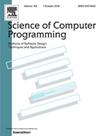TraLogAnomaly: A microservice system anomaly detection approach based on hybrid event sequences
IF 1.4
4区 计算机科学
Q3 COMPUTER SCIENCE, SOFTWARE ENGINEERING
引用次数: 0
Abstract
Microservice architecture has been increasingly adopted to develop various distributed systems due to, amongst other things, its flexibility and scalability. A microservice system often involves numerous invocations among services, making it vulnerable to potential anomalies such as improper configurations of services and improper coordination among services. Existing anomaly detection techniques either identify inter-service anomalies by constructing distributed traces or identify intra-service anomalies by mining features from system logs. However, the intra-service and inter-service behaviors may couple with each other, leading to complex anomalies that may escape detection through the individual examination of traces or logs. In this paper, we propose TraLogAnomaly, an approach for microservice-system anomaly detection. TraLogAnomaly proposes hybrid event vector sequences (HVSs) integrating both inter-service traces and intra-service logs and then identifies the anomalies' patterns from these HVSs. It extracts the patterns of anomalies with the help of a Transformer model. Term frequency-inverse document frequency (TF-IDF) is applied to weighted features learned from hybrid sequences. By integrating information from diverse data sources, the HVSs enhance the ability of these patterns to capture complex system behavior, cover multiple layers of system information, and have higher context-awareness. In addition, TraLogAnomaly also integrates a module that employs agglomeration hierarchical clustering to mine trace patterns of performance anomalies. Empirical results based on widely-used benchmarks show that TraLogAnomaly achieves a high F1-score for detecting anomalies of different types.
TraLogAnomaly:基于混合事件序列的微服务系统异常检测方法
由于其灵活性和可扩展性,微服务架构越来越多地被用于开发各种分布式系统。微服务系统通常涉及服务之间的大量调用,使其容易受到潜在异常的影响,例如服务配置不当和服务之间的协调不当。现有的异常检测技术要么通过构造分布式跟踪来识别服务间异常,要么通过从系统日志中挖掘特征来识别服务内异常。但是,服务内行为和服务间行为可能相互耦合,导致复杂的异常,通过单独检查痕迹或日志可能无法检测到。本文提出了一种微服务系统异常检测方法TraLogAnomaly。TraLogAnomaly提出了一种混合事件向量序列(HVSs),它集成了服务间跟踪和服务内部日志,然后从这些HVSs中识别异常模式。它在Transformer模型的帮助下提取异常模式。将词频逆文档频率(TF-IDF)应用于从混合序列中学习的加权特征。通过集成来自不同数据源的信息,HVSs增强了这些模式捕获复杂系统行为的能力,涵盖了多层系统信息,并具有更高的上下文感知能力。此外,TraLogAnomaly还集成了一个模块,该模块使用集聚分层聚类来挖掘性能异常的跟踪模式。基于广泛使用的基准测试的经验结果表明,TraLogAnomaly在检测不同类型的异常时获得了很高的f1分。
本文章由计算机程序翻译,如有差异,请以英文原文为准。
求助全文
约1分钟内获得全文
求助全文
来源期刊

Science of Computer Programming
工程技术-计算机:软件工程
CiteScore
3.80
自引率
0.00%
发文量
76
审稿时长
67 days
期刊介绍:
Science of Computer Programming is dedicated to the distribution of research results in the areas of software systems development, use and maintenance, including the software aspects of hardware design.
The journal has a wide scope ranging from the many facets of methodological foundations to the details of technical issues andthe aspects of industrial practice.
The subjects of interest to SCP cover the entire spectrum of methods for the entire life cycle of software systems, including
• Requirements, specification, design, validation, verification, coding, testing, maintenance, metrics and renovation of software;
• Design, implementation and evaluation of programming languages;
• Programming environments, development tools, visualisation and animation;
• Management of the development process;
• Human factors in software, software for social interaction, software for social computing;
• Cyber physical systems, and software for the interaction between the physical and the machine;
• Software aspects of infrastructure services, system administration, and network management.
 求助内容:
求助内容: 应助结果提醒方式:
应助结果提醒方式:


